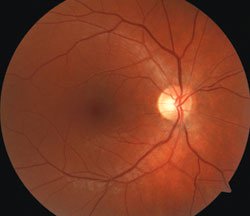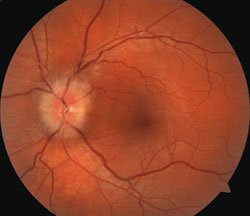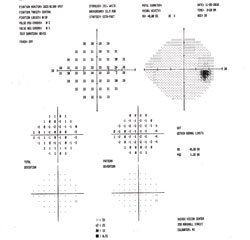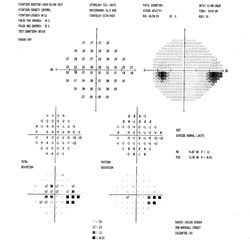Patient self-diagnoses retinal detachment
 John R. Swanson |
A 37-year-old female came to our clinic in August 2008 with a self-diagnosis of a retinal detachment. Her father-in-law had a retinal detachment recently with the same symptoms.
Her chief complaint was flashes in the left eye with occasional blacking out, worse in the periphery, for 2 weeks. The vision in the left eye was out of focus, worse in the dark and with posture changes. She had no headaches, no diplopia and no other symptoms. Her health was good with no medications. She was 1 month post-partum after a normal birth.
The patient’s visual acuity was OD -0.50 D -0.75 D x 093, 20/20; OS -0.25 D -0.75 D x 070, 20/25+2. Cover test was 0 (or ortho); Ishihara was 11/11 OD and OS. Pupils were round, equal and reactive to light with a slight relative afferent pupillary defect (RAPD) in the left eye. Slit lamp exam was unremarkable. IOP was 16 mm Hg in the right eye and 16 mm Hg in the left eye.
|
|
|
|
Dilated fundus exam was normal in the right
eye (left); the disc was flat and perfuse with a 0.3 cup-to-disc ratio and
spontaneous venous pulse. The left fundus (right) revealed a swollen disc grade
2 with a 0.15 cup-to-disc ratio and no venous pulse.
Images: Swanson JR |
|
Dilated fundus exam was normal in the right eye; the disc was flat and perfuse with a 0.3 cup-to-disc ratio and spontaneous venous pulse. The left fundus revealed a swollen disc grade 2 with a 0.15 cup-to-disc ratio and no venous pulse.
My diagnosis was unilateral papilledema, secondary to benign intracranial hypertension. She was referred to a neuro-ophthalmologist at a local university.

What is your diagnosis?
Papilledema by definition is optic disc swelling produced by increased intracranial pressure. Symptoms can be transient, often bilateral vision loss that is intermittent (lasting seconds); headache; diplopia; nausea and, rarely, a mild decrease of visual acuity. Field defects can occur. Other signs include retinal hemorrhages, loss of venous pulsation, enlarged blind spot or other field defects.
Differential diagnoses include pseudo papilledema, papillitis, malignant hypertensive retinopathy, central retinal venous occlusion, ischemic optic neuropathy, optic disc vasculitis, orbital optic nerve tumors, Grave’s disease, uveitis, other inflammatory conditions and pseudotumor cerebri. Pseudotumor cerebri was a consideration following pregnancy even though this patient had already attained normal weight for her height.
Visits with ophthalmologist
At the patient’s first referral visit in September or October 2008, the ophthalmologist had the same findings I did. In addition, that office’s visual field test found a mean deviation of -0.4 dB in the right eye and -4.35 dB in the left eye, with a slightly enlarged blind spot and some nerve fiber bundle defects.
MRI and MRV (magnetic resonance venography) were performed and returned normal. The patient had a lumbar puncture with a normal cerebrospinal fluid formula, with an opening pressure of 13 cm. The working diagnosis was asymmetric pseudotumor cerebri, with the belief that the opening pressure of 13 on the lumbar puncture was a false negative. He started the patient on Diamox (acetazolamide, Duramed) 500 mg three times daily.
|
|
|
|
Her visual field in the left eye (right)
improved to a mean deviation of -4.07 and still showed a nerve bundle fiber
defect. |
|
At the patient’s next visit in January 2009, her visual symptoms had subsided slightly, with a decrease of flashes. Her best-corrected visual acuity was the same, as was her color vision. Field testing showed a mean deviation of -0.4 in the right eye and -5.36 in the left eye. Optic nerve edema was the same in the left eye; the right eye was still normal. Diamox was increased from 1,500 mg/day to 3,000 mg/day.
At the patient’s next visit in March 2009, her visual symptoms were no better, if not worse. Best-corrected visual acuity and color vision were the same. A RAPD was still present in the left eye. Both discs and fields appeared unchanged. The concern at this point was an underlying inflammatory condition such as lupus or sarcoidosis. Blood was drawn for analysis, and a CT scan of the chest, abdomen and pelvis was performed. All of these returned normal and unremarkable. The patient was then started on prednisone 60 mg/day, tapering to 40 mg/day over 8 weeks.
By the patient’s next visit in May 2009, there was still no improvement in visual symptoms. All visual testing results were the same, including the unilateral disc edema. The visual fields were unchanged, and a RAPD was still present in the left eye. MRIs of the orbits were done again. Imaging showed an enhancing mass on the optic nerve; this is most consistent with optic sheath meningioma.
In summary, this patient has persistent unilateral disc edema in the left eye, with no improvement with Diamox or high-dose prednisone. If this were inflammatory, there should have been some improvement. At this point, she was referred for evaluation to radiation oncology for radiation therapy for presumed optic sheath meningioma.
The etiology of compressive optic neuropathy can include optic nerve glioma, optic nerve meningioma or intraorbital masses. Optic nerve meningioma usually affects adult women, with orbital imaging showing an optic nerve mass or diffuse optic nerve thickening.
Return for annual exam
The patient returned for her annual eye exam with no visual complaints. She had undergone 30 radiation treatments for optic nerve sheath meningioma. Her best-corrected visual acuity was still 20/20 OD and 20/25 OS. The entire exam was unremarkable except trace optic disc elevation in the left eye, with RAPD, also trace. The patient was off Diamox and prednisone at that time. At her university visit 1 month later the same results were found.
Her next annual exam in November 2010 was again normal, and she had no visual complaints. Her visual field in the left eye improved to a mean deviation of -4.07 and still showed a nerve bundle fiber defect. There was no visible disc edema in the left eye. There was still a slight RAPD in the left eye; IOP was 14 mm Hg in both eyes.
This case illustrates the inconsistency of symptoms and the power of suggestion. Fortunately, the patient’s awareness of her father-in-law’s condition brought her to care. In summary, our patient had an optic nerve sheath meningioma for which she had radiation treatments with an excellent response. Our plan is to see her annually for examination. She will also have an MRI in 1 year.

- John R. Swanson, OD, is in group practice at Sussex Vision Center, Quincy, Mich. He can be reached at jrswanson@mail.com.
- Edited by Leo P. Semes, OD, a professor of optometry, University of Alabama at Birmingham and a member of the Primary Care Optometry News Editorial Board. He may be reached at 1716 University Blvd., Birmingham, AL 35294-0010; (205) 934-6773; fax: (205) 934-6758; lsemes@uab.edu.
- Disclosure: Dr. Swanson has no direct financial interest in any products mentioned, nor is he a paid consultant for any companies mentioned.




